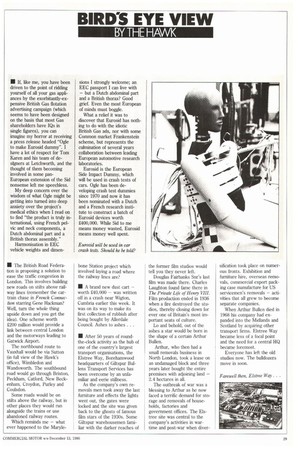• The British Road Federation is proposing a solution to
Page 31

If you've noticed an error in this article please click here to report it so we can fix it.
ease the traffic congestion in London. This involves building new roads on stilts above railway lines (remember the cartrain chase in French Connection starring Gene Hackman? Well, turn the whole thing upside down and you get the idea). One scheme worth £200 million would provide a link between central London and the motorways leading to Gatwick Airport.
The northbound route to Vauxhall would be via Sutton (in full view of the Hawk's office), Wimbledon and Wandsworth. The southbound road would go through Brixton, Peckham, Catford, New Beckenham, Croydon, Purley and Coulsdon.
Some roads would be on stilts above the railway, but in other places they would run alongside the trains or use abandoned railway routes.
Which reminds me — what ever happened to the Maryle bone Station project which involved laying a road where the railway lines are?
• A brand new dust cart — worth £40,000 — was written off in a crash near Wigton, Cumbria earlier this week. It was on its way to make its first collection of rubbish after being bought by Allerdale Council. Ashes to ashes. . .
• After 50 years of roundthe-clock activity as the hub of one of the country's largest transport organisations, the Elstree Way, Borehamwood headquarters of Giltspur Bullens Transport Services has been overcome by an unfamiliar and eerie stillness.
As the company's own removals men took away the last furniture and effects the lights went out, the gates were locked and the site was given back to the ghosts of famous film stars of the 1930s. Some Giltspur warehousemen familiar with the darker reaches of 1 the former film studios would tell you they never left.
Douglas Fairbanks Snr's last film was made there. Charles Laughton found fame there in The Private Life of Henry VIII. Film production ended in 1936 when a fire destroyed the studios, thereby closing down for ever one of Britain's most important seats of culture.
Lo and behold, out of the ashes a star would be born in the shape of a certain Arthur Bullen.
Arthur, who then had a small removals business in North London, took a lease on an undamaged block and three years later bought the entire premises with adjoining land — 2.4 hectares in all.
The outbreak of war was a blessing to Arthur as he now faced a terrific demand for storage and removals of households, factories and government offices. The Elstree site was central to the company's activities in wartime and post-war when diver sification took place on numerous fronts. Exhibition and furniture hire, overseas removals, commercial export packing case manufacture for US servicemen's removals — activities that all grew to become separate companies.
When Arthur Bullen died in 1968 his company had expanded into the Midlands and Scotland by acquiring other transport firms. Elstree Way became less of a focal point and the need for a central HQ became foremost.
Everyone has left the old studios now. The bulldozers move in soon.












































































